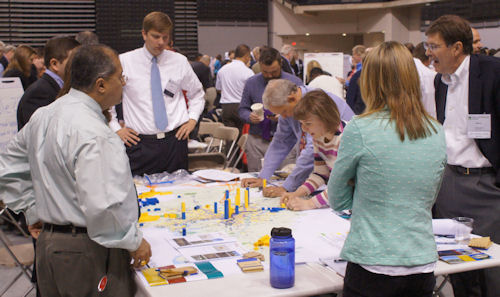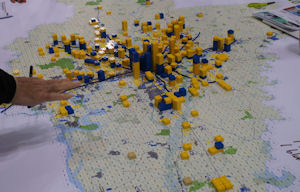by James A. Bacon
By 2035 the Richmond region will grow by roughly 200,000 households (435,000 people) and 200,000 new jobs. That’s a mind-numbing number for a metropolitan region with barely more than 1 million inhabitants today. But, assuming the forecast is valid, where those people wind up living and working will have a dramatic impact on the livability and fiscal sustainability of the region.
Where should they go? The Richmond chapter of the Urban Land Institute (ULI) hosted a Reality Check visioning exercise today in which teams of participants got to play God (or dictator) and decide where the housing and jobs should be located. The idea was to stimulate thinking about the choices the region faces in the years ahead. Participants indicated their priorities by placing Legos on a detailed map of the region, with each blue block representing 156 jobs and each yellow block 312 housing units. (There were also tan blocks for low-density housing.)
As readers of Bacon’s Rebellion know, I have a number of pronounced opinions on the subject. To avoid the temptation of launching into extended pronunciamentos on the subject of growth management or, worse, lunging across the table and snatching Legos from the hands of team mates, I attended as a mere observer. That’s just as well for, judging from what I witnessed, I might have popped from frustration.
While there were a number of well-informed people in attendance — I chatted with two Richmond City Council members, two senior Chesterfield County administrators, two well-known developers and a prominent land-use attorney — most of the attendees were interested local citizens. Citizen input is exceedingly important. But most citizens are ignorant of the economics, politics and fiscal realities of land use and transportation, and I found that ignorance, shall I say… frustrating.
At the same time, I found the basic instincts of the 300 or so participants to be sound. Most of the 10-person teams supported a far more compact, urban-focused development than has prevailed in the past. Richmond has been the fastest-sprawling region in Virginia, much to its detriment. If business, political and civic leaders heed the voices of the Reality Check participants, the region will head in a very different direction.
Reality Check took place in the basketball arena of Virginia Commonwealth University’s Siegel Center. Each team was arrayed around its own table containing a large map of the Richmond region showing building densities and transportation arteries overlaid by a grid of 1/4-square mile squares. The maps depicted no political boundaries. The idea was to treat the region as a single organic unit.
The first step in the exercise was to articulate guiding principles. The big themes running through the sessions included conservation of natural resources, with particular attention to the James River, regional cooperation, preservation of historic assets and mixed use development.
As I wandered from table to table, I observed a surprising commonality in thinking. Each table stacked up Legos on downtown Richmond, already the densest part of the region: both blue for commercial development and, in a departure from current reality, yellow for housing. The Innsbrook office park in western Henrico, now purely commercial, was marked consistently as a second node for mixed-use development. Chesterfield County got lots more medium-density housing. What hardly anyone found appealing was-low density sprawl. If these 300 participants had their way, the development frontier of the Richmond region would not advance one meter in over the next two decades.
Players got to demarcate road upgrades and mass transit routes by laying down orange and blue string. Admittedly, this was an exercise in visioning, not serious planning, but some groups seemed oblivious to basic fiscal principles. First, transportation infrastructure is extraordinarily expensive and, second, you don’t plan a light rail line without planning density around the friggin’ stations!
As Sidney Gunst, developer of the original Innsbrook Office Park and a devotee of Ayn Rand’s philosophy of limited government, observed, Reality Check is an exercise in collectivist thinking. Neither supply and demand nor cost and fiscal limits provided any constraint. Yet he seemed to enjoy himself nonetheless.
After the session was over, VCU students compiled the number of blue and yellow Legos placed on each grid cell on each map. The results will be entered into a spreadsheet and used to replicate a grand unified vision. ULI-Richmond will disseminate the findings to stimulate further discussion of Richmond’s land use future.






